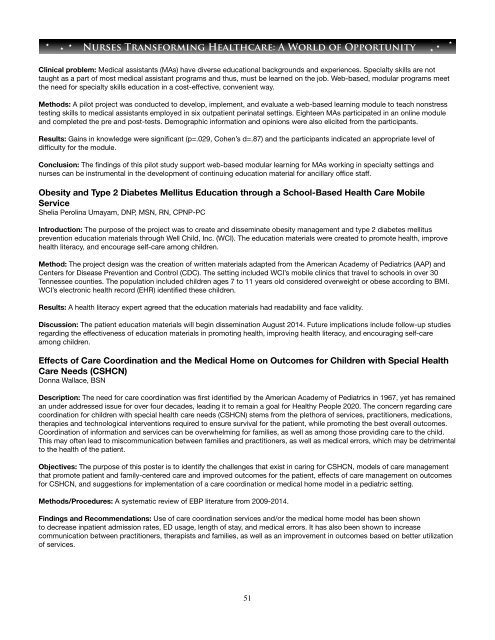2014 Tennessee Nurses Association Conference Yearbook
Create successful ePaper yourself
Turn your PDF publications into a flip-book with our unique Google optimized e-Paper software.
NURSES TRANSFORMING HEALTHCARE: A WORLD OF OPPORTUNITY<br />
Clinical problem: Medical assistants (MAs) have diverse educational backgrounds and experiences. Specialty skills are not<br />
taught as a part of most medical assistant programs and thus, must be learned on the job. Web-based, modular programs meet<br />
the need for specialty skills education in a cost-effective, convenient way.<br />
Methods: A pilot project was conducted to develop, implement, and evaluate a web-based learning module to teach nonstress<br />
testing skills to medical assistants employed in six outpatient perinatal settings. Eighteen MAs participated in an online module<br />
and completed the pre and post-tests. Demographic information and opinions were also elicited from the participants.<br />
Results: Gains in knowledge were significant (p=.029, Cohen’s d=.87) and the participants indicated an appropriate level of<br />
difficulty for the module.<br />
Conclusion: The findings of this pilot study support web-based modular learning for MAs working in specialty settings and<br />
nurses can be instrumental in the development of continuing education material for ancillary office staff.<br />
Obesity and Type 2 Diabetes Mellitus Education through a School-Based Health Care Mobile<br />
Service<br />
Shelia Perolina Umayam, DNP, MSN, RN, CPNP-PC<br />
Introduction: The purpose of the project was to create and disseminate obesity management and type 2 diabetes mellitus<br />
prevention education materials through Well Child, Inc. (WCI). The education materials were created to promote health, improve<br />
health literacy, and encourage self-care among children.<br />
Method: The project design was the creation of written materials adapted from the American Academy of Pediatrics (AAP) and<br />
Centers for Disease Prevention and Control (CDC). The setting included WCI’s mobile clinics that travel to schools in over 30<br />
<strong>Tennessee</strong> counties. The population included children ages 7 to 11 years old considered overweight or obese according to BMI.<br />
WCI’s electronic health record (EHR) identified these children.<br />
Results: A health literacy expert agreed that the education materials had readability and face validity.<br />
Discussion: The patient education materials will begin dissemination August <strong>2014</strong>. Future implications include follow-up studies<br />
regarding the effectiveness of education materials in promoting health, improving health literacy, and encouraging self-care<br />
among children.<br />
Effects of Care Coordination and the Medical Home on Outcomes for Children with Special Health<br />
Care Needs (CSHCN)<br />
Donna Wallace, BSN<br />
Description: The need for care coordination was first identified by the American Academy of Pediatrics in 1967, yet has remained<br />
an under addressed issue for over four decades, leading it to remain a goal for Healthy People 2020. The concern regarding care<br />
coordination for children with special health care needs (CSHCN) stems from the plethora of services, practitioners, medications,<br />
therapies and technological interventions required to ensure survival for the patient, while promoting the best overall outcomes.<br />
Coordination of information and services can be overwhelming for families, as well as among those providing care to the child.<br />
This may often lead to miscommunication between families and practitioners, as well as medical errors, which may be detrimental<br />
to the health of the patient.<br />
Objectives: The purpose of this poster is to identify the challenges that exist in caring for CSHCN, models of care management<br />
that promote patient and family-centered care and improved outcomes for the patient, effects of care management on outcomes<br />
for CSHCN, and suggestions for implementation of a care coordination or medical home model in a pediatric setting.<br />
Methods/Procedures: A systematic review of EBP literature from 2009-<strong>2014</strong>.<br />
Findings and Recommendations: Use of care coordination services and/or the medical home model has been shown<br />
to decrease inpatient admission rates, ED usage, length of stay, and medical errors. It has also been shown to increase<br />
communication between practitioners, therapists and families, as well as an improvement in outcomes based on better utilization<br />
of services.<br />
51

















